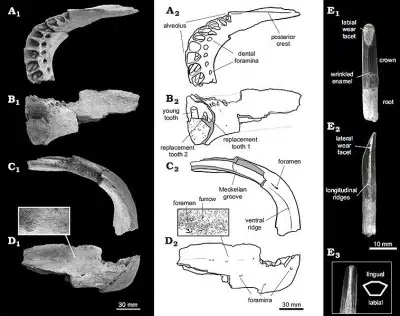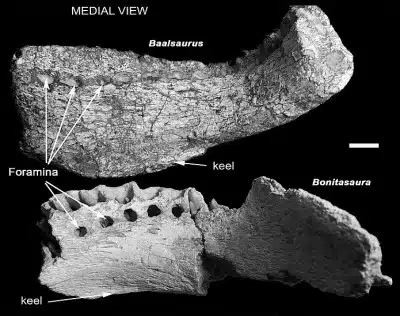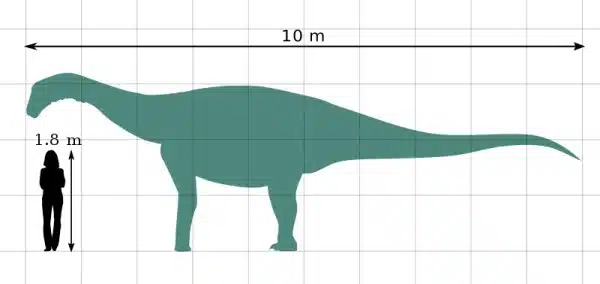Bonitasaura is a relatively recent addition to our paleontological knowledge. Discovered in the rugged terrains of Patagonia, Argentina, this herbivorous sauropod has sparked interest and curiosity among scientists and dinosaur enthusiasts alike.
Bonitasaura, named after the site of its discovery, La Bonita, is a testament to the rich and diverse life that thrived millions of years ago. Its discovery not only adds to the roster of known dinosaurs but also helps paint a more vivid picture of the ecosystems that existed during its time.
Bonitasaura Key Facts
| Keyword | Fact |
|---|---|
| Pronunciation | bon-it-a-sore-rah |
| Meaning of name | La Bonita female reptile |
| Group | Sauropoda |
| Type Species | Bonitasaura salgadoi |
| Diet | Herbivore |
| When it Lived | 86.3 to 72.1 MYA |
| Period | Late Cretaceous |
| Epoch | Santonian to Campanian |
| Length | 33.0 feet |
| Height | Approximately 16.0 feet |
| Weight | Approximately 20.0 tons |
| Mobility | Moved on all four |
| First Discovery | 1999 by Carlos Hugo and Héctor Leanza |
| Described by | 2004 by Sebastian Apesteguía |
| Holotype | MPCA 300 |
| Location of first find | La Bonita hill fossil quarry, Cerro Polica, Ro Negro, Patagonia, Argentina |
Bonitasaura Origins, Taxonomy and Timeline
Bonitasaura, a name that resonates with the beauty of its discovery site, La Bonita, is a fascinating creature from a bygone era. Its name, a combination of the quarry’s name and the Greek word ‘saura’, meaning female reptile, aptly reflects its origins and the essence of its being. Its type species, Bonitasaura salgadoi, honors Leonardo Salgado, an Argentinian paleontologist who worked expensively on sauropods.
In the grand tapestry of dinosaur evolution, Bonitasaura holds a distinct place. As a member of the Titanosauria (Dinosauria: Sauropoda), it shares characteristics with some of the largest creatures to have ever walked the Earth. However, it also possesses unique traits that set it apart, underscoring the incredible diversity that existed within this group.

The timeline of Bonitasaura is rooted in the Late Cretaceous Period, specifically from the Santonian to the Campanian. This time frame, spanning from 86.3 to 72.1 million years ago, was a period of significant changes in the Earth’s ecosystems, climate, and biodiversity. Bonitasaura’s existence during this era offers valuable insights into the life and environment of that time.
Discovery & Fossil Evidence
Bonitasaura was mentioned in a 1999 geological study by Carlos Hugo and Héctor Leanza, in the La Bonita hill fossil quarry, located in Cerro Polica, Ro Negro, Patagonia, Argentina. This discovery, while not broadly heralded as a groundbreaking event in paleontology, nonetheless added a valuable piece to the puzzle of sauropod diversity. The holotype, designated MPCA 300, was formally described in 2004 by Sebastian Apesteguia.
The fossil evidence of Bonitasaura, though limited to this single find, offers a unique window into its existence. The preservation of these remains provides insights into various aspects of the dinosaur, from its physical characteristics to its potential behaviors. Each fragment of bone and trace of its existence helps reconstruct a picture of life millions of years ago.


Despite Bonitasaura not having a vast array of fossil records like some of its contemporaries, the importance of this solitary find cannot be overstated. It represents a snapshot in time, a rare glimpse into a world long gone, and contributes to our understanding of the diverse life forms that once roamed our planet.
Bonitasaura Size and Description
Embarking on a journey to understand Bonitasaura, we first encounter its striking physical characteristics. This sauropod, measuring an impressive 33.0 feet in length, presents a fascinating blend of features that set it apart from its contemporaries.
Description of Bonitasaura
Bonitasaura’s skull bears a resemblance to diplodocids, another group of sauropods, but with its own distinctive traits. Its lower jaw featured a sharp ridge behind a reduced set of teeth, supporting a beak-like keratin sheath in life. This sheath, functioning akin to a guillotine, worked in tandem with the peg-like front teeth to efficiently crop vegetation. This unique feeding mechanism highlights Bonitasaura’s specialized adaptations for its herbivorous diet.
Moreover, Bonitasaura had a relatively short neck, which was compensated by robust projections on the back vertebrae for muscle attachment. This suggests that its neck was used in vigorous exertions, likely during feeding. The convergence of some titanosaurian lines with Diplodocids is evident in Bonitasaura, showcasing evolutionary parallels such as low, long skulls without nasal arches, squared-off lower jaws with comb-like teeth, and reversed limb proportions, where the front limbs were shorter than the hind limbs.
Size and Weight of Type Species

Bonitasaura, with its length of 33.0 feet, was a notable presence in its habitat. While its exact weight remains uncertain, the robust nature of its skeletal structure and muscle attachments suggest a considerable heft. This size, combined with its unique physical features, such as the rudimentary whiplash tails and specialized feeding mechanisms, paints a picture of a dinosaur well-adapted to its environment and the challenges of its time.
Contemporary Dinosaurs
Imagine a world millions of years ago, where the mighty Bonitasaura roamed the ancient landscapes. This remarkable dinosaur, known for its unique snout and powerful build, was a sight to behold. In its world, it coexisted with a variety of other fascinating creatures, each playing a role in the intricate dance of cretaceous life.
Among its contemporaries was Narambuenatitan, a fellow herbivore. These two giants likely shared grazing grounds, perhaps even bumping into each other while munching on the lush vegetation. Bonitasaura, being slightly smaller, might have had to be strategic about its feeding times and locations to avoid direct competition with the larger Narambuenatitan. It’s easy to picture them, like two old friends, silently acknowledging each other’s presence under the ancient sun.
However, life wasn’t all peaceful grazing for Bonitasaura. Predators like Abelisaurus and Carnotaurus roamed the lands, posing a constant threat. Carnotaurus, with its strong legs and fearsome jaws, was particularly daunting. While Bonitasaura was not defenseless, thanks to its size and possibly its tail, the threat from these predators meant it had to be constantly vigilant. The sight of a Carnotaurus on the prowl would have sent a shiver down the spine of any Bonitasaura.
Then there was Bonapartenykus, a contemporary that added another layer to Bonitasaura’s world. This smaller creature, likely a scavenger, might have been seen trailing after the larger dinosaurs, waiting to clean up after their meals or even scavenging the remains of those less fortunate. In this ancient ecosystem, every creature, large or small, played a part in maintaining the balance of life and death.
Interesting Points about Bonitasaura
- Bonitasaura salgadoi’s name is a beautiful homage to its discovery site and to the paleontologist Leonardo Salgado
- The time period of Bonitasaura, the Late Cretaceous, was a pivotal era in Earth’s history, making its study crucial for understanding mesozoic life.
- Despite the limited number of fossils, Bonitasaura’s discovery has significantly contributed to our knowledge of dinosaur biodiversity in South America.
- Bonitasaura’s quadrupedal locomotion and presumed large size highlight the adaptability and survival strategies of sauropods in varying environments.
Bonitasaura in its Natural Habitat
Imagine the world of Bonitasaura, a landscape that was as dynamic as it was diverse. The Late Cretaceous Period in Patagonia, where this sauropod lived, was likely a mosaic of lush vegetation, varying climates, and a rich tapestry of geographical features. This setting provided the perfect backdrop for the life and evolution of Bonitasaura.
As a herbivore, Bonitasaura’s diet was primarily plant-based. Its long neck would have been an asset in reaching vegetation at various heights, from ground-level shrubs to possibly higher tree foliage. The locomotion of Bonitasaura, steady and grounded, suggests a lifestyle that was both nomadic and methodical, traversing vast landscapes in search of food.
The social behavior of Bonitasaura, whether it was a solitary wanderer or a herd animal, remains a subject of speculation. However, its size and presumed diet suggest that it could have played a significant role in shaping the landscape and ecosystem around it. Bonitasaura’s presence in its habitat was not just a matter of existence; it was an integral part of the ecological tapestry of its time.
Frequently Asked Questions
The name Bonitasaura translates to ‘La Bonita female reptile’, named after the site of its discovery in Argentina.
It was discovered in 1999 by Carlos Hugo and Héctor Leanza in Patagonia, Argentina.
Bonitasaura is a titanosaurian sauropod, known for its large size and herbivorous diet.
It moved on all four legs, typical of sauropods, suggesting a steady and deliberate gait.
It lived during the Late Cretaceous Period, approximately 86.3 to 72.1 million years ago.
The first fossil was found at the La Bonita hill fossil quarry in Cerro Polica, Ro Negro, Patagonia, Argentina.
Sources
The information in this article is based on various sources, drawing on scientific research, fossil evidence, and expert analysis. The aim is to provide a comprehensive and accurate overview of Bonitasaura. However, please be aware that our understanding of dinosaurs and their world is constantly evolving as new discoveries are made.
This article was last fact-checked: Joey Arboleda, 11-30-2023
Featured Image Credit: Ghedo, CC BY-SA 3.0, via Wikimedia Commons
